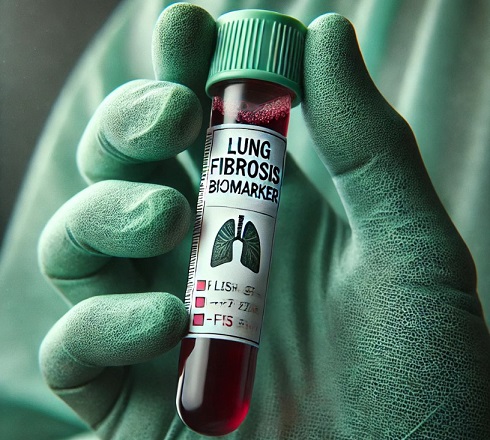Nikhil Prasad Fact checked by:Thailand Medical News Team Jul 10, 2024 1 year, 5 months, 3 weeks, 16 hours, 58 minutes ago
Medical News: Researchers have identified a new biomarker that could revolutionize the early detection and treatment of progressive pulmonary fibrosis (PPF). The study, conducted by a team from various prestigious institutions in Japan and is covered in this
Medical News report, highlights the potential of surfactant protein B (SFTPB) found in serum extracellular vesicles (EVs) as a predictor of disease progression.
 SFTPB - New biomarker discovered for progressive pulmonary fibrosis
SFTPB - New biomarker discovered for progressive pulmonary fibrosis
Image - AI Generated By TMN
Understanding Pulmonary Fibrosis
Pulmonary fibrosis is a serious condition characterized by scarring of the lung tissues, leading to severe breathing difficulties. While idiopathic pulmonary fibrosis (IPF) is the most recognized form, other types of interstitial lung diseases (ILDs) can also progress similarly, necessitating early diagnosis and intervention. Currently, there are no reliable biomarkers to predict the progression of these non-IPF-ILDs, making this discovery particularly significant.
The Discovery of SFTPB
Researchers from Osaka University Graduate School of Medicine, Tokyo University of Science, and several other institutions in Japan conducted a comprehensive proteomic analysis of serum EVs. They aimed to identify novel biomarkers for progressive pulmonary fibrosis or PPF. Their findings revealed that levels of pulmonary surfactant-associated protein B or SFTPB in serum EVs could predict ILD progression better than existing biomarkers like KL-6 and SP-D.
The study involved a multi-step process:
-Proteomic Analysis: The team analyzed serum EVs from 56 PPF cases, 86 non-PPF cases, and 34 healthy controls using liquid chromatography with tandem mass spectrometry (LC-MS/MS). They identified 2,420 proteins, among which SFTPB stood out as a significant predictor of ILD progression. The researchers noted that the levels of SFTPB in serum EVs were significantly elevated in patients with PPF compared to those with non-PPF ILDs and healthy controls. This marked elevation suggested that SFTPB could serve as a reliable indicator of disease progression.
-Clinical Evaluation: Further analysis in two cohorts confirmed that SFTPB levels in serum EVs were more effective in predicting disease progression compared to traditional serum biomarkers.
-Mouse Model Validation: The researchers extended their investigation to a mouse model of bleomycin-induced pulmonary fibrosis, a well-established experimental model for studying lung fibrosis. In this model, they observed that the levels of SFTPB in serum EVs closely mirrored the pro-fibrotic changes occurring in the lung tissues. This finding further validated the clinical relevance of SFTPB as a biomarker for PPF.
The Role of SFTPB
SFTPB is a critical component of lung surfactants, which reduce surface tension in the lungs and are essential for proper respiratory function. The study revealed that SFTPB, particularly its pro-form, increased significantly in patients with PPF.
This form of SFTPB was also found to be a better predictor of disease progression than its mature counterpart, which was undetectable in serum EVs.
Surfactant proteins play a vital role in maintaining lung function by reducing surface tension and preventing the collapse of alveoli, the tiny air sacs in the lungs. Among these proteins, SFTPB is particularly important for its role in surfactant metabolism and lung stability. In the context of pulmonary fibrosis, the increase in SFTPB levels, especially in its immature pro-form, indicates ongoing pathological changes and fibrosis development in the lung tissues.
Implications for Treatment
The identification of SFTPB as a biomarker opens up new avenues for early intervention and personalized treatment in patients with ILD. Early detection is crucial as it allows for timely therapeutic intervention, potentially slowing disease progression and improving patient outcomes.
Early diagnosis and intervention are critical in managing ILDs and preventing severe complications. The ability to predict disease progression using SFTPB levels in serum EVs could enable healthcare providers to identify high-risk patients early and implement appropriate therapeutic strategies. This could lead to improved outcomes and a better quality of life for patients with ILDs.
Future Research Directions
While the study presents promising results, the researchers acknowledge certain limitations, such as the need for larger sample sizes and further validation in diverse patient populations. Additionally, the technical challenges associated with isolating and analyzing EVs in clinical settings need to be addressed.
Future research should focus on expanding the study to include larger and more diverse patient populations to validate the findings further. Additionally, advancements in EV isolation and analysis techniques will be necessary to facilitate the clinical implementation of SFTPB as a biomarker. The development of more accessible and efficient methods for measuring SFTPB levels in serum EVs will be crucial for translating this research into clinical practice.
Conclusion
This groundbreaking research highlights the potential of SFTPB in serum EVs as a predictive biomarker for non-IPF-ILD progression.
The study findings were published in the peer-reviewed journal: JCI Insight.
https://insight.jci.org/articles/view/177937
For the on Fibrosis, keep on logging to Thailand
Medical News.
Read Also:
https://www.thailandmedical.news/news/long-term-lung-healing-even-after-mild-or-moderate-covid-19-many-could-develop-lung-fibrosis
https://www.thailandmedical.news/news/long-covid-news-stanford-study-shows-that-innate-immune-cell-activation-causes-lung-fibrosis-that-can-lead-to-long-covid-breathing-problems
https://www.thailandmedical.news/news/breaking-silent-tsunami-of-post-covid-lung-fibrosis-occurring-among-many-indian-researchers-warn-that-even-asymptomatics-are-at-risk
